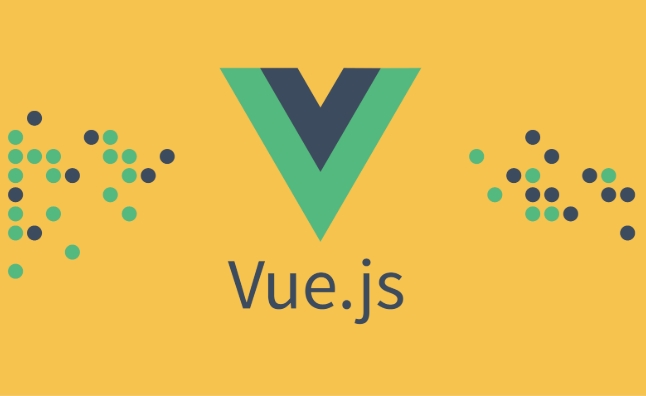This article provides a Vue-based front-end login registration form implementation solution, suitable for beginners. 1. Use Vue to manage the overall status and switch login registration interface; 2. Create login and registration components that contain username and password input items and switch links respectively; 3. Handle login success and exit logic in the main instance; 4. The form implements data binding and basic verification through v-model; 5. It can expand integrated backend requests or enhance front-end verification functions.

sure. Below is a simple Vue login and registration form implementation idea, suitable for developers who are just getting started with Vue. They do not require complex framework knowledge or back-end support (only implementing the front-end interface and basic logic).

Basic structure and preparation
First, make sure you have introduced Vue into your project, whether it is a CDN method of Vue 2 or Vue 3, or a project created through the Vue CLI.
Let's prepare the basic HTML structure first:

<div id="app">
<div v-if="!isLoggedIn">
<login-form v-if="isLogin" @switch-to-register="isLogin = false"></login-form>
<register-form v-else @switch-to-login="isLogin = true"></register-form>
</div>
<div v-else>
<p>Welcome back, {{ username }}! </p>
<button @click="logout">Login</button>
</div>
</div> Then define two components: LoginForm and RegisterForm , which are used for the login and registration interfaces respectively.
Implement the login form component
The login form requires two fields: the username and password, and a "Login" button, and provides a link to switch to the registration page.

const LoginForm = {
template: `
<form @submit.prevent="login">
<h3>Login</h3>
<input v-model="username" placeholder="username" required />
<input v-model="password" type="password" placeholder="password" required />
<button type="submit">Login</button>
<p>No account? <a href="#" @click.prevent="$emit('switch-to-register')">Register</a></p>
</form>
`,
data() {
return {
username: '',
password: ''
};
},
methods: {
login() {
// Simulate login logic if (this.username && this.password) {
this.$emit('login-success', this.username);
} else {
alert('Please enter username and password');
}
}
}
};Implement the registration form component
Registration forms usually require a username, password, confirmation password, as well as a submit button and a link to switch back to login.
const RegisterForm = {
template: `
<form @submit.prevent="register">
<h3>Register</h3>
<input v-model="username" placeholder="username" required />
<input v-model="password" type="password" placeholder="password" required />
<input v-model="confirmPassword" type="password" placeholder="confirmPassword" required />
<button type="submit">Register</button>
<p>Already have an account? <a href="#" @click.prevent="$emit('switch-to-login')">Login</a></p>
</form>
`,
data() {
return {
username: '',
password: '',
confirmPassword: ''
};
},
methods: {
register() {
if (!this.username || !this.password || !this.confirmPassword) {
alert('Please fill in all fields');
return;
}
if (this.password !== this.confirmPassword) {
alert('The password entered twice is inconsistent');
return;
}
// Simulate registration successfully alert('Register successful');
this.$emit('switch-to-login');
}
}
};The main Vue instance controls the overall state
In the main Vue instance, we manage the login status, the currently displayed form type, and the username after the user login.
new Vue({
el: '#app',
components: {
'login-form': LoginForm,
'register-form': RegisterForm
},
data() {
return {
isLogin: true,
isLoggedIn: false,
username: ''
};
},
methods: {
loginSuccess(username) {
this.isLoggedIn = true;
this.username = username;
},
logout() {
this.isLoggedIn = false;
this.username = '';
this.isLogin = true;
}
}
});Tips and notes
- The form verification part can be more complete, such as using Vue's
v-validateplug-in or writing verification functions yourself. - If you plan to connect to the backend API, you can use
axiosorfetchto send the request inlogin()andregister()methods. - Using
v-modelcan simplify bidirectional binding, but be careful to use props and events when passing data between components. - Page switching can be done with
v-ifto control whether the component is rendered, orv-showcan be used to control display and hide.
Basically that's it. You can copy the above code into an HTML file and run it to see the effect. Although there is no backend, it can simulate the basic process of user login and registration.
The above is the detailed content of How to build a simple login and registration form with Vue?. For more information, please follow other related articles on the PHP Chinese website!

Hot AI Tools

Undress AI Tool
Undress images for free

Undresser.AI Undress
AI-powered app for creating realistic nude photos

AI Clothes Remover
Online AI tool for removing clothes from photos.

Clothoff.io
AI clothes remover

Video Face Swap
Swap faces in any video effortlessly with our completely free AI face swap tool!

Hot Article

Hot Tools

Notepad++7.3.1
Easy-to-use and free code editor

SublimeText3 Chinese version
Chinese version, very easy to use

Zend Studio 13.0.1
Powerful PHP integrated development environment

Dreamweaver CS6
Visual web development tools

SublimeText3 Mac version
God-level code editing software (SublimeText3)

Hot Topics
 What is headless UI in Vue?
Jul 08, 2025 am 01:38 AM
What is headless UI in Vue?
Jul 08, 2025 am 01:38 AM
HeadlessUIinVue refers to a library of UI components that provide no preset styles and only contains core logic and behavior. Its features include: 1. No style restrictions, developers can customize the design; 2. Focus on barrier-free and interactive logic, such as keyboard navigation, state management, etc.; 3. Support Vue framework integration, exposing the control interface through combinable functions or components. Reasons for use include: maintaining design consistency, built-in accessibility, strong component reusability, and lightweight library size. In practical applications, developers need to write HTML and CSS themselves. For example, when building a drop-down menu, the library handles state and interaction, while developers decide on visual presentation. Mainstream libraries include HeadlessUI and RadixVue for TailwindLabs, suitable for
 How to watch nested properties in Vue 3?
Jul 07, 2025 am 12:51 AM
How to watch nested properties in Vue 3?
Jul 07, 2025 am 12:51 AM
In Vue3, there are three ways to monitor nested properties using the watch function: 1. Use the getter function to accurately monitor specific nested paths, such as watch(()=>someObject.nested.property,callback); 2. Add the {deep:true} option to deeply monitor changes within the entire object, which is suitable for situations where the structure is complex and does not care about which property changes; 3. Return an array in the getter to listen to multiple nested values ??at the same time, which can be used in combination with deep:true; in addition, if ref is used, the nested properties in its .value need to be tracked through getter.
 How to build a component library with Vue?
Jul 10, 2025 pm 12:14 PM
How to build a component library with Vue?
Jul 10, 2025 pm 12:14 PM
Building a Vue component library requires designing the structure around the business scenario and following the complete process of development, testing and release. 1. The structural design should be classified according to functional modules, including basic components, layout components and business components; 2. Use SCSS or CSS variables to unify the theme and style; 3. Unify the naming specifications and introduce ESLint and Prettier to ensure the consistent code style; 4. Display the usage of components on the supporting document site; 5. Use Vite and other tools to package as NPM packages and configure rollupOptions; 6. Follow the semver specification to manage versions and changelogs when publishing.
 Key differences between Vue 2 and Vue 3?
Jul 09, 2025 am 01:29 AM
Key differences between Vue 2 and Vue 3?
Jul 09, 2025 am 01:29 AM
Vue3 has improved in many key aspects compared to Vue2. 1.Composition API provides a more flexible logical organization method, allowing centralized management of related logic, while still supporting Vue2's Options API; 2. Better performance and smaller package size, the core library is reduced by about 30%, the rendering speed is faster and supports better tree shake optimization; 3. The responsive system uses ES6Proxy to solve the problem of unable to automatically track attribute addition and deletion in Vue2, making the responsive mechanism more natural and consistent; 4. Built-in better support for TypeScript, support multiple node fragments and custom renderer API, improving flexibility and future adaptability. Overall, Vue3 is a smooth upgrade to Vue2,
 How to create a Vue 3 project with Vite?
Jul 05, 2025 am 01:39 AM
How to create a Vue 3 project with Vite?
Jul 05, 2025 am 01:39 AM
It is recommended to use Vite to create Vue3 projects because it uses the browser's native ES module support and has a fast startup speed in development mode. 1. Make sure to install Node.js (16.x or higher) and npm/yarn/pnpm; 2. Run npmcreatevite@latestmy-vue-app--templatevue initialization project; 3. Follow the prompts to select TypeScript, VueRouter and other configurations; 4. Execute cdmy-vue-app and npminstall installation dependencies; 5. Use npmrundev to start the development server. Optional configurations include automatic browser opening, proxy settings, alias paths, and packaging optimizations. Recommended insurance
 How to define routes in vue router?
Jul 05, 2025 am 12:58 AM
How to define routes in vue router?
Jul 05, 2025 am 12:58 AM
Defining routes in Vue projects requires understanding the structure and configuration. The steps are as follows: 1. Install and introduce vue-router, create a routing instance, and pass in a routes array containing path and component; 2. Use dynamic routing matching such as /user/:id to obtain parameters; 3. Use children attribute to implement nested routes; 4. Name the routes with the name attribute for jumping; 5. Use redirect for path redirect. After mastering these core points, you can configure routing efficiently.
 Benefits of using ?
Jul 08, 2025 am 12:20 AM
Benefits of using ?
Jul 08, 2025 am 12:20 AM
? in regular expressions are used to convert greedy matches to non-greedy, achieving more accurate matches. 1. It makes the content as little as possible to match as little as possible to avoid mismatch across tags or fields; 2. It is often used in scenarios such as HTML parsing, log analysis, URL extraction, etc. that require precise control of the scope; 3. When using it, it is necessary to note that not all quantifiers are applicable. Some tools need to manually enable non-greedy mode, and complex structures need to be combined with grouping and assertions to ensure accuracy. Mastering this technique can significantly improve text processing efficiency.
 What is CORS and how does it affect Vue development?
Jul 07, 2025 am 12:11 AM
What is CORS and how does it affect Vue development?
Jul 07, 2025 am 12:11 AM
CORSissuesinVueoccurduetothebrowser'ssame-originpolicywhenthefrontendandbackenddomainsdiffer.Duringdevelopment,configureaproxyinvue.config.jstoredirectAPIrequeststhroughthedevserver.Inproduction,ensurethebackendsetsproperCORSheaders,allowingspecifico






